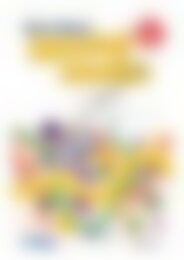PR-6170RUK Science A STEM Approach - Primary 1
Create successful ePaper yourself
Turn your PDF publications into a flip-book with our unique Google optimized e-Paper software.
Materials<br />
MATERIALS HAVE <strong>PR</strong>OPERTIES<br />
Lesson 2<br />
Lesson Plan<br />
Before the lesson, collect five objects each that are made solely from wood, glass, metal and rubber.<br />
Note: Suggestions of easily accessible objects that exhibit a range of properties have been provided<br />
on page 76. Place the objects in a cardboard box and place the box and four hula hoops in the centre<br />
of the mat. Label each hoop with a different material—wood, glass, metal and rubber.<br />
Introduction:<br />
1. As a class, sit in a circle around the cardboard box and the hula hoops. Ask two pupils at a time to<br />
quickly select an object from the box and choose which material they think it is made from. Pupils<br />
should be encouraged to describe their thinking, such as I think this object is made from metal<br />
because it is hard and shiny. Encourage other pupils to, without saying anything, put their hand<br />
up if they disagree with the material choice. The pupil who is sorting the object must then doublecheck<br />
their choice and sit down when finished. Repeat the activity until all pupils have had a turn.<br />
Note: Digital photographs may be taken to use as evidence of pupils sorting objects by the material<br />
it is made from.<br />
Development:<br />
2. While pupils are sitting on the mat, display an enlarged set of the property cards on pages 80 and<br />
81. Encourage pupils to sound out each word. Describe the meaning of the word to pupils with<br />
reference to the image so that pupils can read the words independently during the activity.<br />
3. Divide the class into five groups and give each group an object made of wood and a set of<br />
property cards from pages 80 and 81. Pupils work as a group to explore the properties of the<br />
object they have.<br />
Differentiation<br />
• Less able pupils may be grouped together and given an easy-to-describe object from each<br />
material or be given limited properties to test for each object. An adult helper can assist pupils<br />
to read the property cards and ask pupils questions, such as Can you bend it?<br />
• More able pupils may be grouped together and encouraged to create a poster of the properties<br />
for each material, copying the words from each property card that applies.<br />
4. After a few minutes, pupils share the properties of their group's object with the other groups. As<br />
pupils suggest the properties of their object, add their descriptive words to an A3 piece of paper<br />
to create a poster of the properties of each material.<br />
5. Select a pupil to return their object to the hula hoop on the mat and repeat steps 3 and 4 for the<br />
remaining materials.<br />
Reflection:<br />
6. Using the interactive whiteboard, display the game Grouping and Changing Materials at . Select individual pupils to participate in sorting objects by the material it is<br />
made from—wood, glass, metal and rubber. Pupils explain why they think the object is made from<br />
that material with reference to its observable properties.<br />
Viewing sample<br />
www.prim-ed.com – Prim-Ed Publishing 978-1-912760-14-5 Infants<br />
<strong>Science</strong>:<br />
A <strong>STEM</strong> AP<strong>PR</strong>OACH<br />
79


















